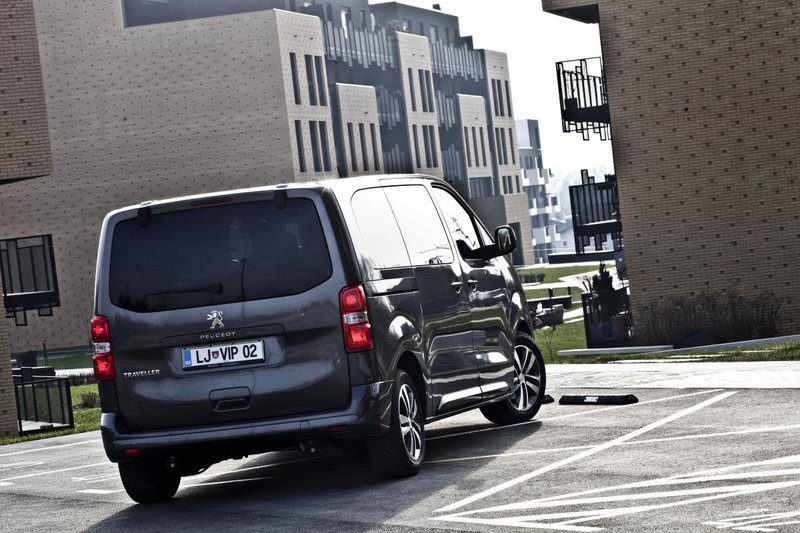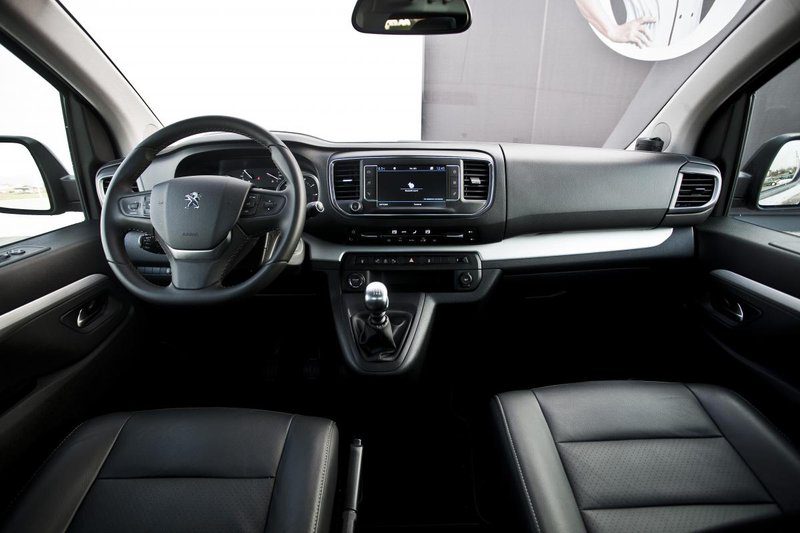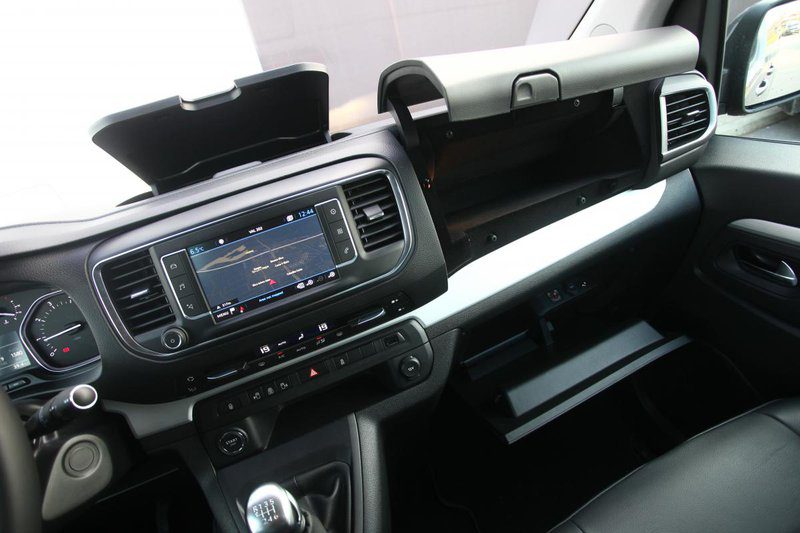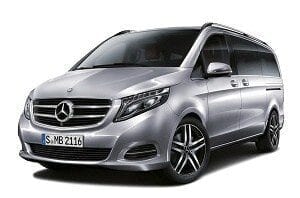
Test: Peugeot Traveler 2.0 BlueHDi 150 BVM6 Stop & Start Allure L2
So, of course, there is some trade-off between the size of a real minibus and the practicality of a large limousine van. The dual nature goes well with this, at least in the richly equipped version we tested. It offers both the spaciousness of a real minibus and the appeal of a more civilized limousine van design.

Comfort for the driver and passengers is ensured by leather seats that provide ample support, while drivers and co-drivers also boast heaters and a massage device for a more relaxed experience on long journeys. Passengers in rear seats with longitudinally movable benches do not have this luxury, but they can regulate heating or ventilation, the bench is movable in the longitudinal direction, and more daylight is provided by large skylights, which, of course, can be closed if necessary. The test car was fitted with only a second row of seats, which is available as an option on the more family-friendly Allure. At the same time, the trunk will be bulky, up to 4.200 liters, and you can store a lot of family or sports equipment in it; However, when you remove the bench from it, it still affects transport relations. It can also only store items through the rear window, which opens independently of the door, otherwise, as with most such vehicles, you will have to open the large, heavy tailgate.

Given the rather luxurious and comfortable nature of the test Traveler, one would expect them to have the option of electric opening or even shock actuation under the rear, but they are completely manual. Their opposite is side sliding doors, where the electric drive can be activated in many ways: by directly pulling on the handles, using switches next to the door and on the dashboard, or even by kicking under the rear of the car. The last method - in the settings for such a doorway, you can add a car unlock or turn it off completely - may seem unusual, but in the case of family use, it makes a lot of sense. He will be especially pleased with parents who are busy with their children or someone else.
Compared to the Expert Tepee - and to a lesser extent the Peugeot 807 - it has gained more comfort in a passenger compartment that is not only spacious, but also better arranged and finished. There are plenty of places to store larger or smaller items.

The driver is given a car-like working environment and there are a number of accessories available, some of which seem quite obvious to us and others not so obvious. These are, for example, the head-up screen, which displays information about the speed and status of the cruise control and the speed limiter, as well as warning vehicles in the blind spot. The range of entertainment and information aids is also extensive. The front view is excellent from the van's point of view, and the rear is also limited in the van. Therefore, ultrasonic sensors are very welcome when reversing, and we would have been even happier with reversing cameras, which were not on the test car, but which can be ordered as accessories.

On the way, the Wanderer lives up to all our expectations. The suspension is tuned for comfort, although it sometimes surprises with a slightly more pronounced obstacle response, the tilt is not too great, and the 150-liter four-cylinder turbo diesel with a XNUMX horsepower six-speed manual transmission is a solid job with the weight of the car. It only really bothers me with the clutch pedal, which grips unusually high and surprises again and again. Sometimes it is even so much that it is necessary to restart the engine, which can be a little inconvenient, especially at intersections.

Fuel consumption, which Traveler also tried to reduce in the test with a fairly efficient start-stop system, was - for such a large car - a solid 8,4 liters, but it could also be driven much more economically, since it was higher. a comparable standard projectile consumed 6,1 liters of diesel fuel per 100 kilometers.

The 4,95-meter Peugeot Traveler is an interesting choice as a minibus or a large limousine van. Those who value compact dimensions more than spaciousness can present it in a version 35 centimeters shorter; If you never have enough space, the Traveler can be 35 centimeters longer and even more spacious.
text: Matija Janezic · photo: Sasha Kapetanovich
Also read tests of related cars:
Citroën Spacetourer Feel M BlueHdi 150 S&S BVM6
Peugeot 807 2.2 HDi FAP Premium

Traveler 2.0 BlueHDi 150 BVM6 Stop & Start Allure L2 (2017)
Basic data
| Sales: | Peugeot Slovenia doo |
|---|---|
| Base model price: | 41.422 € |
| Test model cost: | 35.451 € |
| Power: | 110kW (150 KM) |
| Acceleration (0-100 km / h): | 11,0 with |
| Maximum speed: | 170 km / h |
| Mixed flow ECE: | 6,1l / 100km |
| Guarantee: | General warranty two years without mileage limitation, 3 years warranty for varnish, 12 years warranty for rust, mobile guarantee |
| Systematic review | 40.000 km or 2 years. km |
Cost (up to 100.000 km or five years)
| Regular services, works, materials: | 1.208 € |
|---|---|
| Fuel: | 7.332 € |
| Tires (1) | 1.516 € |
| Loss of value (within 5 years): | 11.224 € |
| Compulsory insurance: | 3.480 € |
| CASCO INSURANCE (+ B, K), AO, AO + | 7.750 ( |
| Calculate the cost of auto insurance | |
| Buy up | € 32.510 0,33 (km cost: XNUMX €) |
Technical information
| engine: | 4-cylinder – 4-stroke – in-line – turbodiesel – front transversely mounted – bore and stroke 85 × 88 mm – displacement 1.997 cm3 – compression ratio 16:1 – maximum power 110 kW (150 hp) at 4.000 rpm / min - average piston speed at maximum power 11,7 m / s - specific power 55,1 kW / l (74,9 hp / l) - maximum torque 370 Nm at 2.000 rpm - 2 camshafts in head (belt) - 4 valves per cylinder - common rail fuel injection - exhaust gas turbocharger - charge air cooler. |
|---|---|
| Energy transfer: | engine driven by front wheels - 6-speed manual gearbox - np ratios - np differential - 7,5 J × 17 wheels - 225/55 R 17 V tires, rolling range 2,05 m |
| Transportation and suspension: | minibus - 5 doors, 5 seats - self-supporting body - front single suspension, coil springs, three-spoke wishbones, stabilizer - rear rigid axle, coil springs, stabilizer - front disc brakes (forced cooling), rear disc brakes, ABS, mechanical rear parking brake wheels (lever between seats) - steering wheel with gear rack, electric power steering, 3,5 turns between extreme points. |
| Mass: | empty vehicle 1.630 kg - permissible total weight 2.740 kg - permissible trailer weight with brake: 2.300 kg, without brake: 750 kg - permissible roof load: np Payload: maximum speed 170 km/h - acceleration 0–100 km/h 11,0, 5,3 s – average fuel consumption (ECE) 100 l / 2 km, CO139 emissions XNUMX g / km. |
| External dimensions: | length 4.956 mm - width 1.920 mm, with mirrors 2.210 mm - height 1.890 mm - wheelbase 3.275 mm - front track 1.627 mm - rear 1.600 mm - rideney krog 12,4 m |
| Inner dimensions: | longitudinal front 860-1.000 mm, middle 630-920, back 670-840 mm - front width 1.520 mm, average 1.560 mm, rear 1.570 mm - headroom in front 960-1.030 mm, center 1.020, rear 960 mm - front seat length 490 mm, middle seat 430, rear seat 430 mm - trunk 550-4.200 l - steering wheel diameter 380 mm - fuel tank 69 l. |
